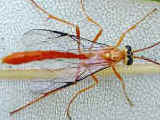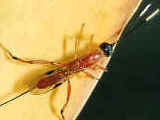|
| |
Superfamily ICHNEUMONOIDEA - Ichneumon Wasps and Braconid Wasps
- This page contains pictures and information about Ichneumon Wasps and Braconid Wasps
in Superfamily Ichneumonidae that we
found in the Brisbane area, Queensland, Australia.
-
 -
- In the Superfamily Ichneumonidae there are only two two families, Ichneumonidae
and Braconidae. Ichneumon Wasps and Braconid Wasps are the largest group in Hymenoptera. Because of their
parasitic habit, most of their life cycle details are still unknown.
-
- Their larvae are either parasitic
or predators. Most caterpillar are targeted host. Some species attacked other
insects and spiders. The female wasp usually locates the food plants of the host
then searches with her antennae for a suitable host. The female
usually has the long ovipositor which is used to insert eggs into the host body.
Some species lay eggs externally and attack the host from outside. The host will
usually survive when the larvae is still living. Until the larvae fully grown,
the larvae either pupates inside the dead host or form a cocoon outside. Larvae
may be single or in group within the host.
-

 - Ichneumon Wasp
Braconid Wasp
-
- Parasitic Wasps mainly belong to Family Ichneumonidae and Family Braconidae.
They can be distinguished from other
wasps by their costal cell on forewings
is absent. Veins C and R fused together. Wasps in this two families are
looked very similar. The can be distinguished by their
wings vein which Ichneumon Wasps have the extra vein while Braconid Wasps have
not.
-
- The antenna are not elbowed, long and thin, almost always more than 11
segments. They have long and thin body, with narrow waist like other
wasps. Females have ovipositor often prominent and long. Adults are active in day
time and feed on flowers. Some species are brightly coloured.
 Family Ichneumonidae Family Ichneumonidae - Members in this family have long and thin body, with narrow waist. Adults
are active in day time and feed on flowers. Some species are colourful. The female usually has the
long ovipositor which is used to insert eggs into the host body. Some species
lay eggs externally and attack the host from outside. The host will usually
survive when the larvae is still living. Until the larvae fully grown, the
larvae either pupates inside the dead host or form a cocoon outside.
-
-
-
-
 Family
Braconidae Family
Braconidae- Members in this family are usually small in size. Their larvae are
parasitic. The host will usually survive when the larvae is still living.
Until the larvae fully grown, the larvae either pupates inside the dead host
or form a cocoon outside. Many aphid parasites are braconid and their life
cycles are similar.
-
-
-
-
- Reference:
- 1. Insects
of Australia, CSIRO, Division of Entomology, Melbourne University
Press, 2nd Edition 1991, pp 930.
- 2. Northern
Territory Insects, A Comprehensive Guide CD - Graham Brown, 2009.
- 3. What
wasp is that? - An interactive identification guide to the
Australasian families of Hymenoptera, 2007.
- 4. A
field guide to insects in Australia - by Paul Zborowski and Ross
Storey, Reed New Holland, 1996, p183.
- 5. Ichneumonidae
- The Ecology of Commanster, James Keith Lindsey.
- 6. Insects of Australia and New Zealand - R. J. Tillyard, Angus
& Robertson, Ltd, Sydney, 1926, p269.
[ ICHNEUMONIDAE ]
| |
|



 Family Ichneumonidae
Family Ichneumonidae  Family
Braconidae
Family
Braconidae